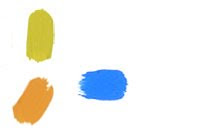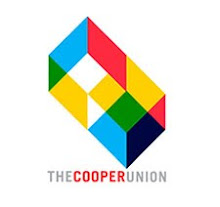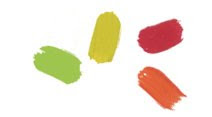Friday, March 26, 2010
A Bit About the Process
A friend recently suggested that I write about the process that produces a painting. Every artist I've ever known or read about works differently so this will be about my own style. While my operation is simple, there are endless variations. Today I'll describe what I have been doing for the last month or so in my studio.
I have several stacks of semi-resolved collage paintings. These are sorted according to size and each stack has anywhere from twenty to forty layers separated by a sheet of paper, each layer a painting in several pieces almost ready to be adhered to a backing. The painting might look complete and ready but I am not. I look over each layer, adjust the manner in which the pieces are placed in relation to each other, maybe remove a piece, perhaps insert another. Then I put the whole stack aside again. This can go on for years until one day, I decide it's time to finish some. There is no rhyme or reason to this; it just happens. The determination is in place.
So I go over some of these paintings in progress, intent now on making each the best it can be. The final decisions, before mounting a work into its "engraved in stone" ultimate form are about fine tuning the color choices and proportions, but mostly about the coherence, strength and some all-important other quality which I would describe thusly: it fulfills its purpose, it measures up, it's a keeper. So I finish by adhering it to its backing and then take it to another level by adding final touches of pastel or some other medium.
I am baffled when asked about how long it takes me to make a painting because I really don't know.
The image above is Autumn Quintet ©1994, Mixed Media on Etching Paper 20 x 16" each. For information about any of the paintings on this site, please email Joan.
Friday, March 19, 2010
About Art and Technology
I hear some disapproval about the use of technology in art. Rational thinking (my own, of course) postulates that the computer with its software and the printer with its inks are tools as much as anything else we might use. Some of the paints I work with are made of modern synthetic pigments. They are intense, clean, clear colors with unpronounceable names. Mark Rothko bought paint made with non-permanent dyes, guaranteed to fade, from Woolworth’s, to achieve the intensity of color he wanted. The Rothko mural that hung in the library at Yale looked like my bedsheets after some years went by, the original beautiful color gone forever. The archival printing inks we use now will last longer than the paints he used. Longer even than some contemporary paints.
Technology has transformed music, made movie and theater experiences surreal, caused great innovations in architecture and influenced the arts in ways most of us are still amazed by. It can transform the artist into a magician.
I like to paint “pieces”, rectangles and squares and stripes of color using a variety of media. I make these on paper and then assemble them into paintings by adhering the pieces to canvas or board. I scan or photograph some of the painted pieces, manipulate the image on my computer and print these images. This adds to the riches I can choose from as I search for exactly the right piece of color, texture and “feel” to resolve a collage painting. If the tools I use had been available to Rothko, Picasso and Michelangelo, I know they would have used them without apology.
The image above is Antares, acrylic and mixed media collage on archival board, 25 x 25", 2007. For information about any of the paintings seen on this site please email Joan.
Friday, March 12, 2010
About the Survival of Art and Intellect
I feel sorrow when I read of devastated and looted museums or libraries destroyed by fire or natural disasters. Books and paintings have been burned because they were deemed degenerate. Maybe some weren’t great losses but surely many were. While this is tragic, I believe that people are born every day who can and will produce sculptures, paintings, books, music and all possible art forms every bit as worthy of survival as the revered icons of the past.
The benefit of preserving these works of art lies not in so much in their intrinsic value but in how they connect us to our human history. In high school we learned (or not) about governments rising and falling, battles won or lost, treaties signed, countries partitioned and renamed, and lots and lots of dates to remember. It was a revelation to me when, in my first year in college, we read the ancient Greek plays. There was meaning in these: anger, jealousy, envy, grief, and humor. Way back in ancient times they experienced life as I knew it. Of course battles raged in these stories and governments toppled, but now history was about people.
More than four hundred years B.C. Aristophanes wrote about Lysistrata, who instigates a peace movement during the time of the Peloponnesian war. Her ploy: “Every wife and mistress is to refuse all sexual favors whatsoever, till the men have come to terms of peace.” The play is still pertinent and funny. The lesson I learned from that play and others of that era was about how little we have changed and about wisdom not being a modern phenomenon. I appreciate that works of art can connect us to ourselves.
The image above is the miniature Agena, acrylic & mixed media collage, 7 x 4", 2005. For information about any of the paintings seen on this site please email Joan.
The benefit of preserving these works of art lies not in so much in their intrinsic value but in how they connect us to our human history. In high school we learned (or not) about governments rising and falling, battles won or lost, treaties signed, countries partitioned and renamed, and lots and lots of dates to remember. It was a revelation to me when, in my first year in college, we read the ancient Greek plays. There was meaning in these: anger, jealousy, envy, grief, and humor. Way back in ancient times they experienced life as I knew it. Of course battles raged in these stories and governments toppled, but now history was about people.
More than four hundred years B.C. Aristophanes wrote about Lysistrata, who instigates a peace movement during the time of the Peloponnesian war. Her ploy: “Every wife and mistress is to refuse all sexual favors whatsoever, till the men have come to terms of peace.” The play is still pertinent and funny. The lesson I learned from that play and others of that era was about how little we have changed and about wisdom not being a modern phenomenon. I appreciate that works of art can connect us to ourselves.
The image above is the miniature Agena, acrylic & mixed media collage, 7 x 4", 2005. For information about any of the paintings seen on this site please email Joan.
Friday, March 5, 2010
About Abstraction
There are so many definitions and descriptions of abstract art that I’m going to take the liberty here of defining it according to my own bias. Some of the muddier versions have to do with abstracting from “nature” whatever that is, from the “real” world, (again, whatever that is). There is abstract expressionism, geometric abstraction, color-field, pop art, op art, hard edge painting, and non-representational and non-pictorial painting, and more.
A painting is a mirage. If it looks like a face, don’t be fooled. If it looks like a barn or a mountain stream, it’s not. It’s whatever media the artist used applied to a surface. What looks like a horse in a pasture is an illusion. It’s the artist’s version of what he sees or thinks he sees or invents.
I have no problem with landscape and portraiture and I’m quite partial to still lifes. I do take issue with those who denigrate art that its creator invents without any discernible reference to something outside the painting, (my definition of abstract painting). I am fond of repeating something that Vincent Van Gogh wrote in a letter to his brother Theo. He rose one morning wanting to paint a certain combination of yellow and blue. He trudged down a dusty road carting canvas and paints until he found the haystack and sky that suited his vision. The painting was not a landscape. It was the vessel that contained his great love for color in a world he left too soon.
It has been more than a hundred years since abstraction in its various forms appeared in our western culture, though it was part and parcel of many native arts and the arts of older civilizations long before that. It would seem unnecessary to explain or defend it in an age of computer generated art, conceptual art and some of the other contemporary forms of creative expression to be experienced now. Still, I find myself often maybe not so much defending as explaining.
On my last visit to New York I visited the New Museum for the first time. In a center space on the second floor, in the show called “Younger Than Jesus” there was a person napping in a bed. This volunteer was drugged and she slumbered untroubled by the close inspection from museum visitors. Was she real? Definitely. One foot was revealed by the tangled blanket. Looked like she could have used a bath. Was it art? I really didn’t care. It was fun and made the show more interesting.
We who call our work “abstract” or something along that line, are availing ourselves of whatever freedom our individual stock of boldness provides. I still struggle to secure the courage of my convictions. Here’s Georgia O’Keefe: "I have lived on a razor’s edge. So what if you fall off, I'd rather be doing something I really wanted to do. I'd walk it again."
The image above is Mini Triptych Nashira, acrylic & mixed media collage, 4.5 x 3" each, 2005. For information about any of the paintings seen on this site please email Joan.
Subscribe to:
Posts (Atom)













